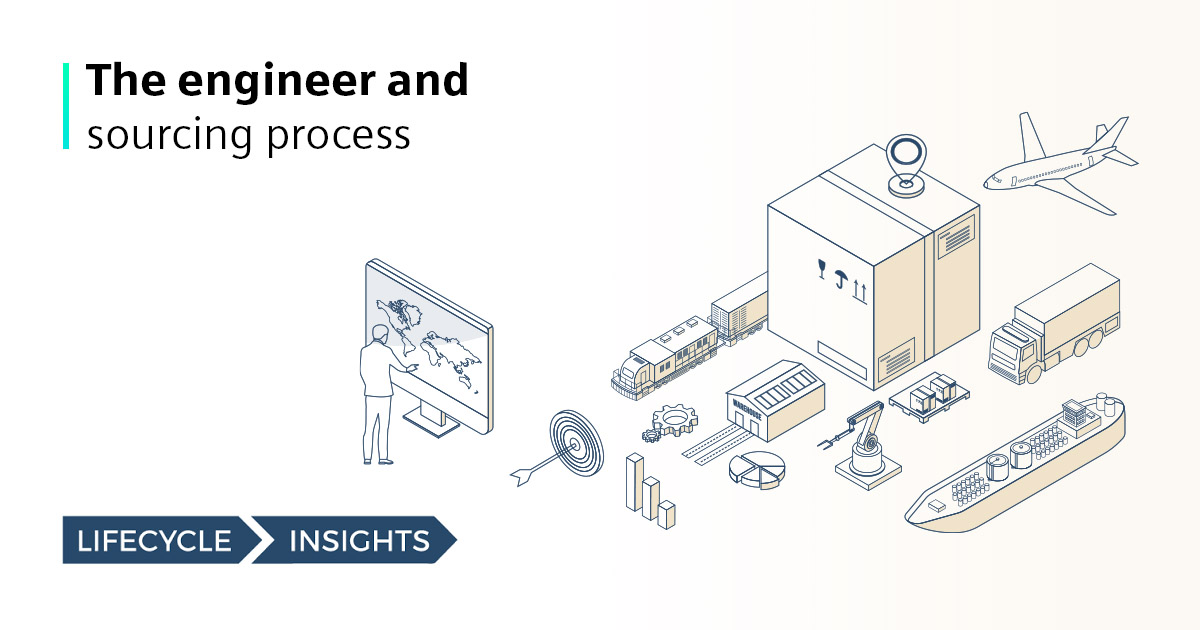The engineer and the electronic component sourcing process – how to streamline that today and streamline BOM verification

This blog was written by Chad Jackson, Chief Analyst & CEO at Lifecycle Insights, and comments have been provided throughout by Stephen Chavez, one of our own product marketing managers. Check it out and join the conversation below!
The manufacturing industry has seen incredible disruption in its supply chains over the past few years. Experts expect those disruptions to continue in the future. Given this landscape, companies cannot assume that their chosen components—or even components they’ve used in the past—will still be available as the product moves from design into production. To stay on schedule and within budget, organizations must implement modern design flows with electronic component sourcing processes that have been optimized to adapt quickly to existing and new supply chain disruptions.
Component supply issues disrupt projects
For most design organizations, electronic component sourcing is a strategic and planned exercise. They consider the requirements for any given product and then identify specific suppliers. Typically, this sourcing process will give them important information regarding lead times for specific components.
In a recent Lifecycle Insights’ survey, the Electronics Design for Resilience (EDfR) Study, 41% of respondents reported their board development projects require unplanned qualification and missed cost targets due to component sourcing issues. This is not a surprise. When component supply issues arise, it forces a spot buy. Spot sourcing can be unpredictable—and is typically performed by the printed circuit board (PCB) manufacturer, not a procurement professional. The end result is that spot buys are costly, since they are not purchased in advance, when suppliers have the adequate lead time required to work with the component manufacturers to fulfill the component order. As a result, companies may be hit with rush charges or left with no alternative but to purchase a higher-priced component.

The survey results showing 41% doesn’t surprise me. What does surprise me is that these spot buys tend to add fuel to the fire. Companies start to panic and buy abnormally large quantities. Leading to increased bottom line cost that eventually creates shockwaves throughout the industry. This has caused a form of a thermal runaway until nothing was left on the shelf or in the warehouse.
I’d like to mention another side effect we are seeing… individual part costs have gone up. A colleague informed me that in a recent BOM analysis, a part that he was purchasing last year at $2.50 per part is now around $20 per part. That’s an 8X markup! Now imagine a BOM with several hundred parts or more. Talk about supply and demand…
Stephen V. Chavez, MIT, CPCD, CID+ | Sr. Product Marketing Manager
Pitfalls of the traditional electronic component sourcing process
Historically, organizations relied on a linear sourcing processing to help them make component purchases. The design engineer would select components and then create a bill of materials (BOM) during the design phase. Often, this selection process would occur without much concern about the design time required to complete the PCB layout and ready it for fabrication.
Lifecycle Insights’ 2022 EDfR Study, however, found that 44% of sourcing is still done through supplier websites. Some organizations even start the process with a broad internet search. While these processes may have worked in the past, the current state of the supply chain makes it a challenge to rely on these approaches without costly delays or respins.
Traditional design and procurement systems do not provide real-time component intelligence. They also do not facilitate collaboration with project stakeholders during the sourcing process so that issues can be addressed when the cost of changes won’t be an impediment to production or time to market.

The legacy electronic component sourcing process simply doesn’t cut it anymore, yet the survey confirms that companies are still functioning with the same old methodologies that lack real-time component intelligence, while trying to meet the challenges in today’s economic environments.
Stephen V. Chavez, MIT, CPCD, CID+ | Sr. Product Marketing Manager
Transitioning from a sole source to a multi-source design flow
Facilitating a connected supply chain flow that provides real-time component intelligence and supports stakeholder collaboration requires a change from traditional processes. Companies must transition from a historically siloed sourcing workflow to one that is more resilient and managed throughout the entire design process. This workflow must also be specifically structured to support collaboration between supply sources and design stakeholders. Unlike the traditional, linear process, the new sourcing process must be concurrent and integrated.
To mitigate any sourcing issues, companies should strive to create a flow that is rich with multi-source cost information at the very beginning of BOM development. This will help to ensure that they have access to current inventory, scheduling, and the most up-to-date pricing for the components they seek. An integrated flow offers organizations real-time supply intelligence to help with BOM analysis throughout design—and can then alert stakeholders when the supply of a particular component has been compromised so they can respond without delay.

This hits the nail on the head regarding where the issue lies. I call it the “Ah-ha” moment in the process. Intelligence at the point of design is key! In my recently published white paper, figure three depicts an excellent view of current state of siloed teams, spider-web like communication networks, and legacy operation of doing business with intelligent data touch points external to the ecosystem. Figure four and figure five in that same white paper are great examples of today’s current linear workflow that lack intelligence at the point of design.
Stephen V. Chavez, MIT, CPCD, CID+ | Sr. Product Marketing Manager
Avoiding supply disruption when cost of change is lowest
Companies that transition to a sourcing flow that facilitates better supply chain visibility will see numerous benefits. To start, it will give stakeholders the information they need to select components based on quality, cost, availability, and performance. Stakeholders will have access to multiple sources of component data so they can identify alternate parts early in the design process. Then they can source an alternate part seamlessly in the event of an unexpected supply chain issue.
Design teams and other stakeholders can also use the real-time intelligence provided by such a sourcing flow to avoid supply issues. When component intelligence and insights are available, design teams are alerted to any potential problems and can act early to soften associated costs. The end result is that companies are better prepared for any supply chain disruptions and can better mitigate the costs and delays involved when they do occur.

Yes! Intelligent decision making further upstream in the process is key to managing risk, mitigating delays and lowering cost. The ability to arm engineers with commodity intelligence and gain better component insight for better decision-making allows engineering teams to adapt and overcome issues potentially even before they are magnified.
Stephen V. Chavez, MIT, CPCD, CID+ | Sr. Product Marketing Manager
Mitigating supply chain risks with real-time component sourcing
Supply chain disruptions aren’t going anywhere. Even as manufacturers put the COVID-19 pandemic behind them, the supply chain can still be affected by a multitude of factors, ranging from natural disasters to cyber attacks. That is why it is vital that manufacturers of electronic products implement modern design flows with real-time component sourcing processes and intelligence. In doing so, they will be better able to respond to supply chain disruptions more quickly and easily, avoiding costly delays and rework.

Everyone really needs to be aware that these supply-chain disruptions aren’t going anywhere any time soon. Unfortunately, the cost of doing business is higher than ever and increasing, influenced by a global electronics value chain already facing rapidly dynamic market forces that are being amplified by the pandemic and global chip shortages. So yes, we need to implement modern design flows with real-time component sourcing processes and intelligence to have the best potential for overall success.
Stephen V. Chavez, MIT, CPCD, CID+ | Sr. Product Marketing Manager


